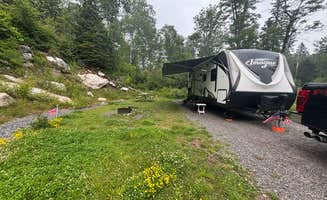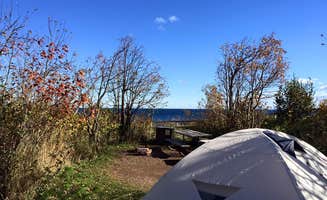Camping sites near Silver Bay, Minnesota position visitors between inland forest and Lake Superior shoreline, with elevations ranging from 600 to 1,800 feet across the region. Winter camping remains available at several locations despite Minnesota's northern latitude, with temperatures dropping below 0°F from December through February. The area's dense mixed forests create natural windbreaks at many campsites.
What to do
Hiking waterfall trails: The Baptism River in Tettegouche State Park offers multiple waterfall hikes with varying difficulty levels. "The park itself is a delightfully quick hike away from the falls. You can hear them at night, and it is very peaceful," notes Lauren M. The High Falls and Two Step Falls are accessible via a 1.5 mile round trip, though "Two step falls has 200 stairs so beware," according to B M.
Backcountry lakes: Silver Bay provides access to more remote lake camping at inland sites. "This campsite is set right on the shore of a pristine lake surrounded by forest covered hills," writes Bri M. about Bean and Bear Lakes Hike-In. The lake water is "clear enough to purify for drinking water or cooking" and provides "swimming, fishing, and paddling opportunities."
Winter exploration: Unlike many Minnesota destinations, some Silver Bay area campgrounds remain open year-round. "Minnesotans are a hardy lot. Hence, winter camping at state park campsites is still possible... Unlike many state, winter camping starts in October and goes through April," explains Janet R. about Gooseberry Falls State Park. Winter visitors should prepare for reduced services, as "the shower houses and campground bathrooms have the water shut off in winter."
What campers like
Secluded shoreline: Lake Superior cart-in sites offer privacy with lake views. "The cart-in campground is right on Lake Superior and has very private sites," mentions Jenna H. about Lake Superior Cart-in Campground. Sites provide "privacy from other sites" and "scramble down to the rocks" access to watch sunrises over the lake, though Sarah D. notes "the walk to these cart in campsites was wayyyy longer than other cart in sites."
Rustic river campsites: First-come-first-served forest sites along rivers provide budget alternatives to state parks. "Excellent little primitive campground. First come, no reservations, cash or cheque for payment only," writes Arctic D. about Finland State Forest. "Every spot for camping had a very sound fire ring and flat area for tents. Spots by the river are the nicest."
Star viewing opportunities: Clear nights away from city lights create optimal stargazing conditions at certain campsites. "There is a rocky outcrop in the middle of the site that is a perfect platform to lay down on and stargaze," notes Jeremy B. about George H. Crosby Manitou State Park, though he mentions "there isn't a lot of great star-gazing because of the tree cover" at some sites.
What you should know
Rugged terrain challenges: Some hiking trails and backcountry campgrounds require moderate to advanced outdoor skills. "The trails of this park are either a hikers dream or nightmare. Exposed roots, large rocks, and elevation changes are common. Good potential for a twisted ankle," warns Jeremy B. about George H. Crosby Manitou. "I would not advise bringing small children or inexperienced hikers."
Noise considerations: Highway proximity affects campground quiet at some locations. "The sites are closer to the highway than we would have liked (you could hear the road noise)," reports Amy G. Karl R. adds about Black Beach Campground that it's "very noisy with the roar of traffic on hwy 61 all night. ATVs coming and going at all hours."
Water access logistics: Many campsites require water planning strategies. "There is no dump station. Newer campground with nice roads and good spots," notes Dave M. about Shipwreck Creek Campground, adding "there are water hydrants in the campground, but you cannot do dishes or fill your camper from them."
Tips for camping with families
Accessible waterfall options: Families with children should select campgrounds with easier trail access. "Awesome park for exploring. There are tons of stairs on one trail, but they are worth it to see the top of the waterfall and walk the swing bridge," recommends Samantha B. about Baptism River Campground. For easier alternatives, "there is the Bensen Lake trail that is a wooden boardwalk that rings Bensen Lake."
Site selection for privacy: Choose exterior loop sites for better family camping experiences. "We stayed in site C4. It was a great spot to have with kids," shares Zack H. about Split Rock Lighthouse State Park. "It was a good balance of rustic with a side of comfort. It was a quiet and spacious site."
Winter family camping: For cold-weather camping with children, select sites with vehicle proximity. "When we were here there were no tent campers, but a handful of RV campers and car campers," mentions Janet R. about winter camping at Gooseberry Falls. "Its worth doing if you know how to stay warm and don't mind the limited park services."
Tips from RVers
Site selection strategy: RV campers should prioritize sites farther from highways. "We stayed in site #28, sewer, water and electric, a nice site," shares Tom about Black Beach Campground, adding that "campsites are well maintained and easy to get into." Nick K. recommends "if you are in the spaces closer to the lake you would probably want to drive to the showers."
Hookup availability: Full hookup options vary widely between campgrounds. "Easy access to trails from campground," notes Terri L. about Baptism River Campground, while Scott B. shares about Shipwreck Creek that "the sites have electric hook ups" but notes "no dump or water fill on site but we used the SP down the road for that without issue."
Size limitations: Some campgrounds accommodate larger rigs better than others. "We are 47 feet without the truck and fit in a 50 foot spot. 55 foot with our rear deck extended," explains Joe C. about Shipwreck Creek Campground, which features "spacious RV spots with additional tent sites on each one."













